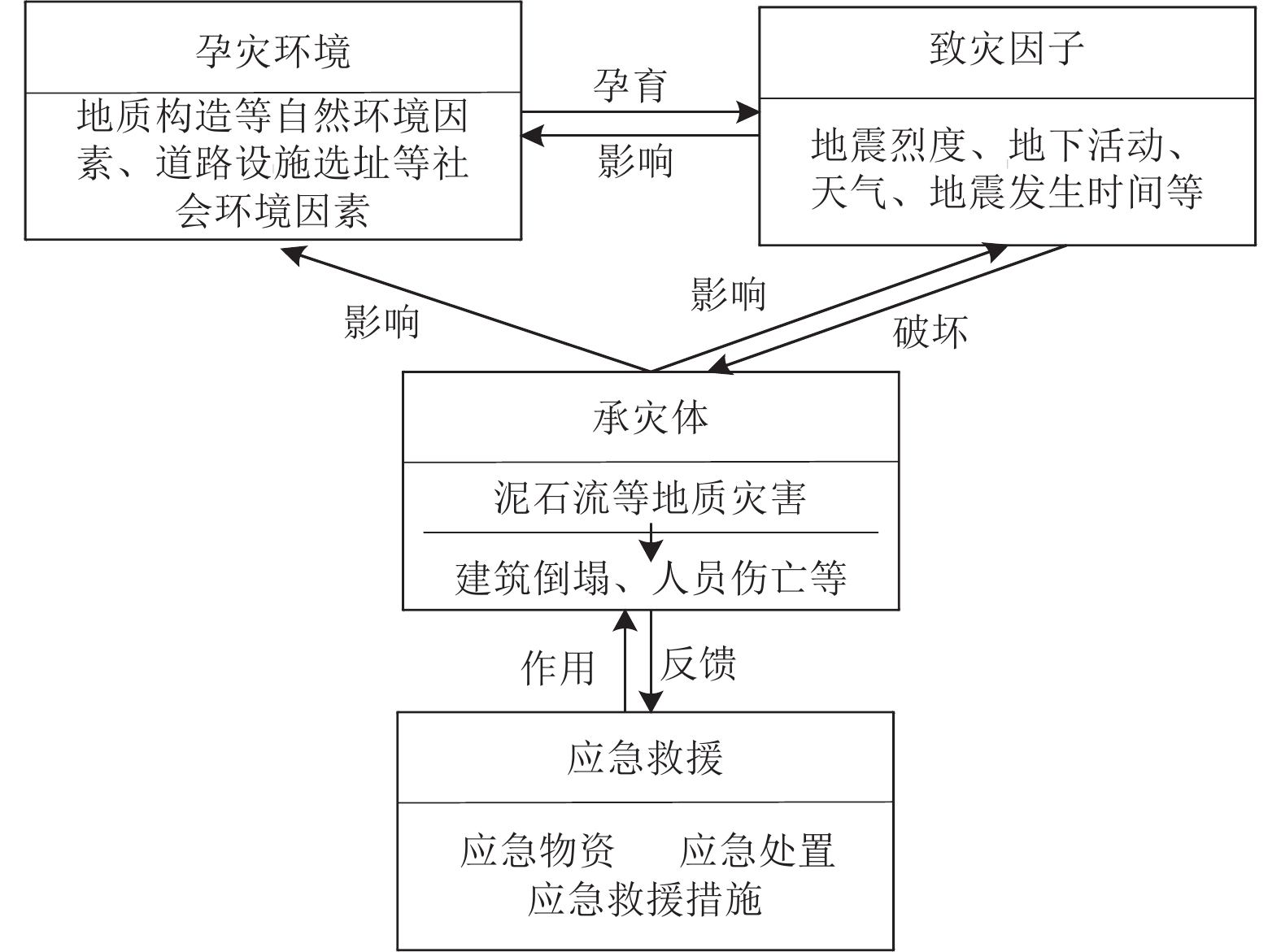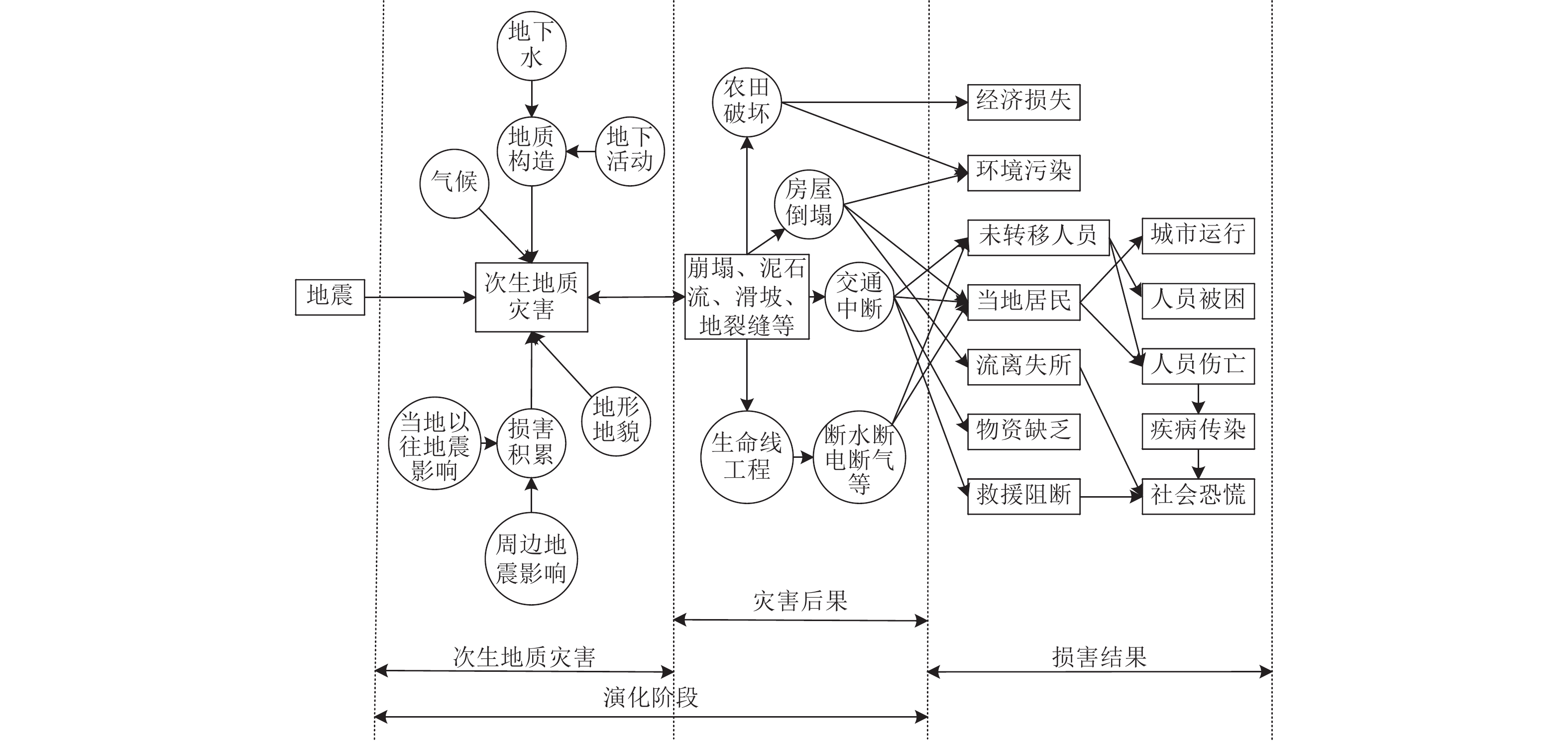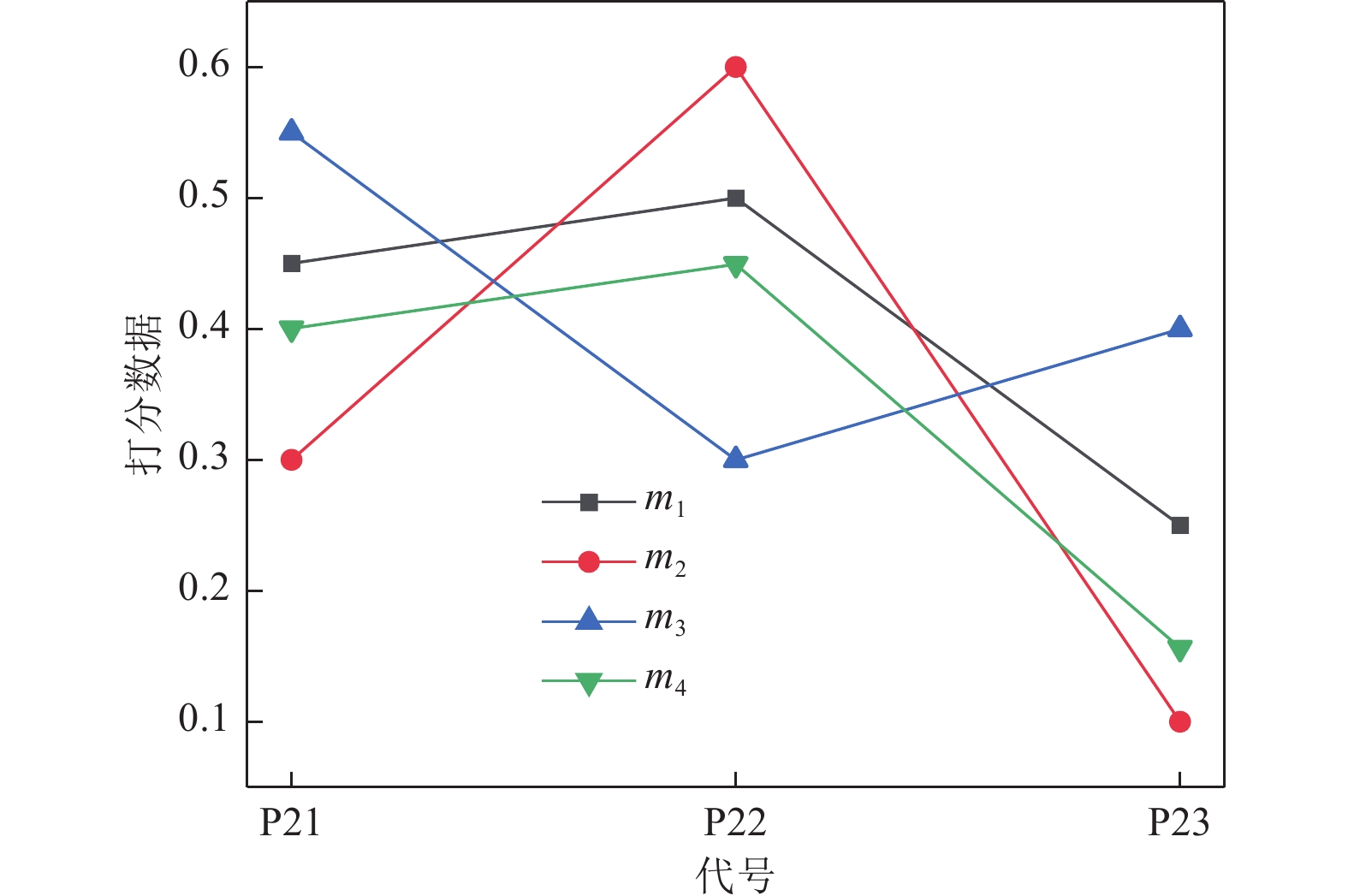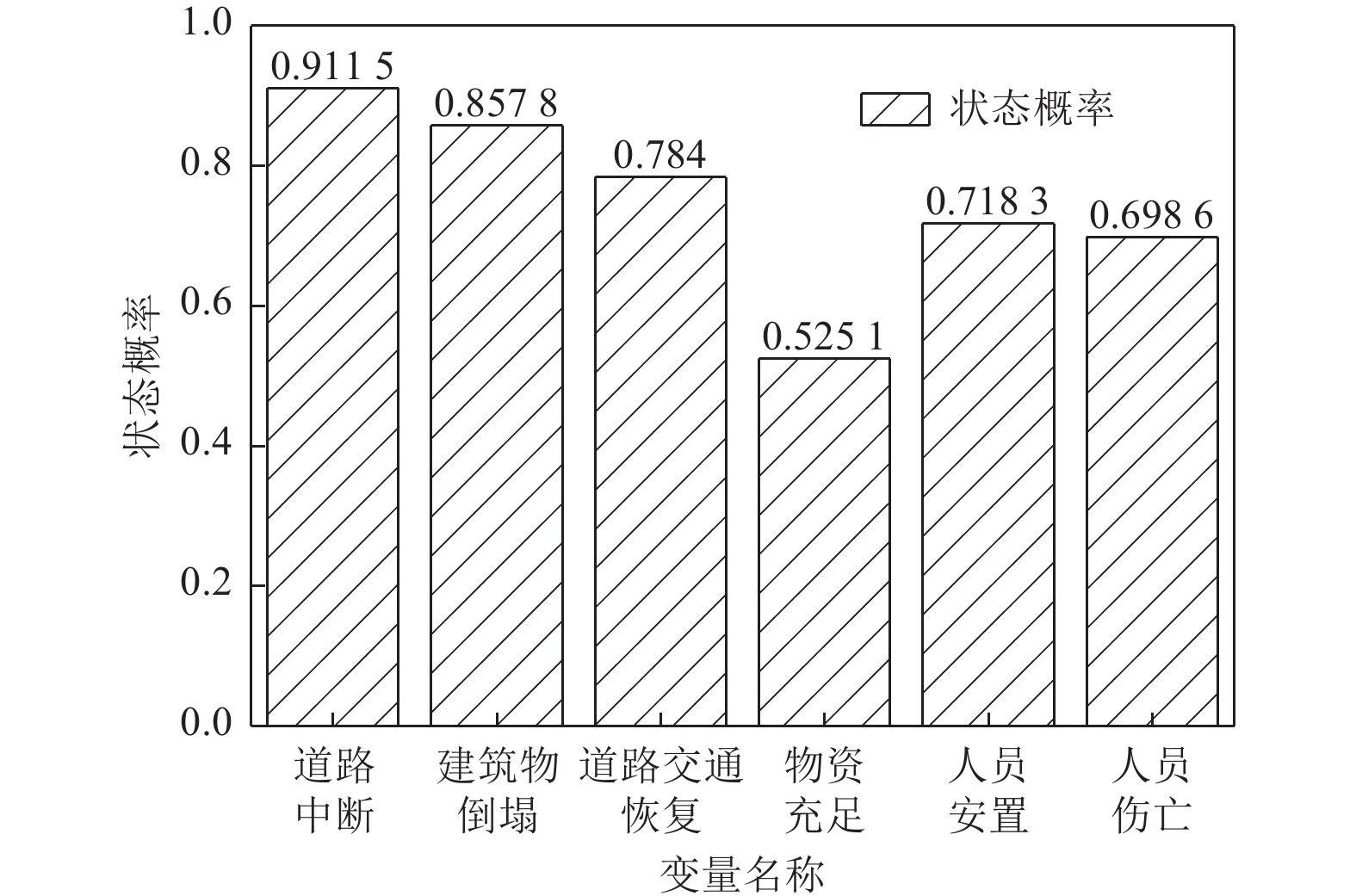Evolutionary Analysis of Earthquake Secondary Geological Disasters Scenario Based on Knowledge Element and Bayesian Network
-
摘要: 根据以往地震发生后现场实际破坏数据可知,地震次生地质灾害已造成严重的灾区人员伤亡和经济损失,为此,需对地震次生地质灾害情景进行演化分析。为了解地震次生地质灾害的演化过程,首先基于突发事件知识元模型,对地震次生地质灾害情景组成要素进行分析。其次基于贝叶斯模型,明确构成地震次生地质灾害演化贝叶斯网络的节点变量及其取值范围,根据这些节点变量之间的因果关系和专家打分,建立贝叶斯网络图和节点变量条件概率模型。并利用证据理论将概率融合修正,计算次生地质灾害下关键节点状态概率,实现事故关键情景的推演。最后结合知识元模型和构建的地震次生地质灾害贝叶斯网络模型,对临夏积石山6.2级地震发生后导致的次生地质灾害情景进行分析。Abstract: Based on field data from previous earthquakes, it is evident that secondary geological disasters triggered by seismic events have caused significant casualties and economic losses in affected areas. Consequently, it is essential to analyze the evolutionary scenarios of these secondary disasters. To understand the progression of earthquake-induced secondary geological hazards, this study first analyzes the components of such disaster scenarios using a critical incident knowledge element model. Then, a Bayesian network is constructed by identifying the key node variables, their value ranges, and the causal relationships among them. A corresponding Bayesian network diagram and a conditional probability model are developed, informed by expert scoring. Evidence theory is applied to refine probability fusion, enabling the calculation of the likelihood of critical node states during secondary disasters and facilitating the deduction of potential accident scenarios. Finally, the evolutionary process of secondary geological disasters following the M6.2 Linxia Jishishan earthquake is examined through the integrated use of the knowledge element model and the Bayesian network framework.
-
表 1 知识元模型各变量含义
Table 1. Definit ion of variables in the knowledge element model
变量 含义 $ {K}_{m} $ 共性知识 $ {N}_{m} $ 概念或属性名 $ {A}_{m} $ 状态集 $ {R}_{m} $ 属性状态变化关系集 $ {p}_{a} $ 可测特征描述 $ {d}_{a} $ 测度量纲集 $ {f}_{a} $ 关系规则 $ {p}_{r} $ 属性特征描述或辨识方法特征 $ {A}_{r}^{I} $ 输入属性状态集 $ {A}_{r}^{O} $ 输出属性状态集 $ {f}_{r} $ 输入属性到输出属性之间的具体映射函数$ {A}_{r}^{I}={f}_{r}\left({A}_{r}^{O}\right) $ 表 2 地震次生地质灾害事故演化过程
Table 2. Evolutionary process of secondary geological disaster accident of earthquake
名称 事故情景简述 四川汶川地震 2008年5月12日地震发生,诱发大量泥石流、滑坡、崩塌、堰塞湖等地质灾害;交通、通信、电力、供水等生命线系统以及相关企业、水利工程等遭到破坏;事故造成人员伤亡、经济损失;应急救援人员展开抗灾救援工作;最后,对灾区进行灾后重建。 青海玉树地震 2010年4月14日地震发生,诱发滑坡、崩塌、山体震裂;水渠溃决、砂土液化等导致山体局部地质灾害加剧,房屋倒塌;交通、通信、电力等生命线工程损坏;事故造成人员伤亡、经济损失;应急救援人员展开抗灾救援工作;最后,对灾区进行灾后重建。 ······ ······ 四川九寨沟 2017年8月8日地震发生,地震区域位于高山峡谷,10年内发生了2次强震,加剧了山体内部结构的破坏,诱发滚石、崩塌等地质隐患,房屋破坏;交通、通信、电力等生命线工程损坏;事故造成人员伤亡、经济损失;应急救援人员展开抗灾救援工作;最后,对灾区进行灾后重建。 表 3 地震次生地质属性及环境属性变量离散化方法
Table 3. Discretization method for secondary geological and environmental attribute variables of earthquake
序号 变量 组数 取值范围 1 地震烈度 4 VIII/IX/X/XI 2 地震发生时间 2 易伤亡时间/相对安全时间 3 天气 3 南方雨季:4~10月;北方雨季:6~9月/高温/降雪、冬季(寒冷地区) 4 地下水位 2 地下水位高度影响地质灾害{是,否} 5 地下活动 2 地下活动影响地质灾害{是,否} 6 范围影响 2 遭受范围影响{是,否} 表 4 贝叶斯网络中部分节点状态变量离散化分布
Table 4. Discretized distribution of state variables of some nodes in Bayesian network
序号 变量 状态值 1 灌溉区 是否属于灌溉区{是,否} 2 地震次生地质灾害导致人员伤亡 是否伤亡{是,否} 3 地震次生地质灾害导致建筑物倒塌 是否倒塌{是,否} 4 地震次生地质灾害导致通讯中断 是否中断{是,否} 5 地震次生地质灾害导致交通中断 是否中断{是,否} 6 地震次生地质灾害导致供水、电、气等基础设施破坏 是否破坏{是,否} 7 崩塌 是否发生{是,否} 8 滑坡 是否发生{是,否} 9 泥石流 是否发生{是,否} 10 滚石 是否发生{是,否} 11 地裂缝 是否发生{是,否} 12 地震次生地质灾害导致救援阻断 是否受到阻断{是,否} 13 建筑物倒塌导致人员伤亡 人员伤亡{是,否} 14 建筑物倒塌导致救援阻断 是否受到阻断{是,否} 15 疾病传染 是否有疾病传染{是,否} 16 环境污染 环境污染是否处于正常情况{是,否} 17 生活物资缺乏 物资缺乏{是,否} 18 社会恐慌 是否发生{是,否} 表 5 基本事件概率分布
Table 5. Probability distribution of fundamental event
事件名称 概率分布(先验概率) 地震烈度 {0.34,0.5,0.08,0.08} 震发时间 {0.33,0.67} 天气 {0.33,0.67} 地下水位 {0.5,0.5} 灌溉区 {0.5,0.5} 地震次生地质灾害导致建筑物倒塌 {1,0} 地震次生地质灾害导致交通中断 {0.9,0.1} 地震次生地质灾害导致供水、电、气等基础设施破坏 {0.7,0.3} 地质灾害 {0.9,0.1} 次生灾害导致救援中断 {0.4,0.6} 表 6 积石山地震灾害事件情景要素表示
Table 6. Representation of the elements of scenario for the earthquake disaster event in the Jishishan
情景阶段 情景要素 初始情景 孕灾环境:饱和黄土稳定强度E1,冬灌E2,范围
影响E3致灾因子:地震烈度H1 发展情景 致灾因子:滑坡-泥流灾害H2,地下水位上升H3,
道路交通恢复H4,灾害消退H5承灾体:建筑物倒塌情况C1,供水、供电、通讯
中断情况C2,道路中断情况C3,人员伤亡情况C4应急救援:交通管制、疏导M1,临时安置M2,及
时救援M3结束情景 承灾体:灾后区域恢复C5 应急救援:应急救援物资发放M4,人员安置M5,
建筑房屋灾后重建M6,疾病防疫M7表 7 滑坡-泥流节点变量条件概率打分及证据合成结果
Table 7. Conditional probability score for the landslide-debris flow node variable and synthesis results of evidence
代号 条件概率 m1 m2 m3 m P21 p(H21|E1) 0.45 0.3 0.55 0.400333 P22 p(H22|E1) 0.5 0.6 0.3 0.449333 P23 p(H23|E1) 0.25 0.1 0.4 0.156250 表 8 节点变量状态概率分布
Table 8. Probability distribution of node variable state
情景阶段 变量名称 取值范围 状态概率 初始情景 饱和黄土稳定强度 不稳定/稳定 (1,0)证据信息 冬灌导致地下水位上升 发生/未发生 (1,0)证据信息 范围影响 是/否 (1,0)证据信息 地震烈度 VIII/IX/X/XI (1,0,0,0)证据信息 发展情景 滑坡-泥流灾害 严重/不严重/无 ( 0.4034 ,0.3977 ,0.1989 )建筑物倒塌 严重/不严重/无 ( 0.4517 ,0.4061 ,0.1422 )道路中断 是/否 ( 0.9115 ,0.0885 )供水、电等基础设施破坏 是/否 ( 0.8794 ,0.1206 )交通管制、疏导 是/否 ( 0.9514 ,0.0486 )道路交通恢复 是/否 ( 0.7840 ,0.2160 )临时安置 是/否 ( 0.9393 ,0.0607 )及时救援 是/否 ( 0.8048 ,0.1952 )灾害消退 是/否 ( 0.6719 ,0.3081 )人员伤亡 严重/不严重/无 ( 0.3434 ,0.3552 ,0.3014 )结束情景 人员安置 是/否 ( 0.7183 ,0.2817 )应急救援物资 充足/不足 ( 0.5251 ,0.4749 )建筑房屋灾后重建 是/否 ( 0.9623 ,0.0377 )疾病防疫 是/否 ( 0.9260 ,0.0740 )灾后区域恢复 是/否 ( 0.8794 ,0.1206 ) -
陈波,王芳,肖本夫,2021. “情景-应对”型理论体系的发展及其在地震灾害应急管理中的应用探讨. 震灾防御技术,16(4):605−616. doi: 10.11899/j.issn.1673-5722.2021.4.zzfyjs202104001Chen B., Wang F., Xiao B. F., 2021. The development of “Scenario-response” theoretical system and its application in earthquake disaster emergency management. Technology for Earthquake Disaster Prevention, 16(4): 605−616. (in Chinese) doi: 10.11899/j.issn.1673-5722.2021.4.zzfyjs202104001 陈博,李振洪,黄武彪等,2022. 2022年四川泸定Mw6.6级地震诱发地质灾害空间分布及影响因素. 地球科学与环境学报,44(6):971−985.Chen B., Li Z. H., Huang W. B., et al., 2022. Spatial distribution and influencing factors of Geohazards induced by the 2022 Mw6.6 Luding (Sichuan, China) earthquake. Journal of Earth Sciences and Environment, 44(6): 971−985. (in Chinese) 杜镇瀚,钟启明,董海洲等,2023. 基于贝叶斯网络的堰塞坝稳定性快速评价模型. 水利水电科技进展,43(4):37−45. doi: 10.3880/j.issn.1006-7647.2023.04.006Du Z. H., Zhong Q. M., Dong H. Z., et al., 2023. Rapid evaluation method of landslide dam stability based on Bayesian network. Advances in Science and Technology of Water Resources, 43(4): 37−45. (in Chinese) doi: 10.3880/j.issn.1006-7647.2023.04.006 范维澄,刘奕,2009. 城市公共安全体系架构分析. 城市管理与科技,11(5):38−41. doi: 10.3969/j.issn.1008-2271.2009.05.015Fan W. C., Liu Y., 2009. Analysis of urban public safety system structure. Urban Management Science & Technology, 11(5): 38−41. (in Chinese) doi: 10.3969/j.issn.1008-2271.2009.05.015 方丹辉,于款,万端翼等,2021. 基于贝叶斯网络的地震次生灾害情景演化分析. 武汉理工大学学报(信息与管理工程版),43(6):493−499. doi: 10.3963/j.issn.2095-3852.2021.06.001Fang D. H., Yu K., Wan D. Y., et al., 2021. Scenario evolution analysis of earthquake secondary disasters based on Bayesian network. Journal of Wuhan University of Technology (Information & Management Engineering), 43(6): 493−499. (in Chinese) doi: 10.3963/j.issn.2095-3852.2021.06.001 顾一波,霍宇芒,2016. 基于贝叶斯网络的地震次生燃气管道泄漏事件链构建. 中国安全生产科学技术,12(7):134−139.Gu Y. B., Huo Y. M., 2016. Construction of event chain for secondary gas pipeline leakage induced by earthquake based on Bayesian network. Journal of Safety Science and Technology, 12(7): 134−139. (in Chinese) 郭富赟,张永军,窦晓东等,2024. 甘肃积石山MS6.2地震次生地质灾害分布规律与发育特征. 兰州大学学报(自然科学版),60(1):6−12.Guo F. Y. , Zhang Y. J. , Dou X. D. , et al. 2024. Distribution patterns and development characteristics of secondary geological hazards caused by the MS6.2 earthquake in Jishishan, Gansu. Journal of Lanzhou University (Natural Sciences), 60(1): 6−12. (in Chinese) 李蕾,聂冠军,2020. 广西地区地震次生地质灾害类型及分布特征. 灾害学,35(3):118−124. doi: 10.3969/j.issn.1000-811X.2020.03.023Li L., Nie G. J., 2020. Types and distribution characteristics of secondary geological disasters in Guangxi. Journal of Catastrophology, 35(3): 118−124. (in Chinese) doi: 10.3969/j.issn.1000-811X.2020.03.023 廖勇,徐闯,陈军等,2021. 四川长宁“6·17”地震诱发的次生地质灾害类型及其发育特征. 中国地质灾害与防治学报,32(1):77−83.Liao Y., Xu C., Chen J., et al., 2021. Types and their characteristics of geological hazards triggered by “6·17” earthquake in Changning, Sichuan Province. The Chinese Journal of Geological Hazard and Control, 32(1): 77−83. (in Chinese) 刘凤民,张立海,刘海青等,2006. 中国地震次生地质灾害危险性评价. 地质力学学报,12(2):127−131. doi: 10.3969/j.issn.1006-6616.2006.02.003Liu F. M., Zhang L. H., Liu H. Q., et al., 2006. Danger assessment of earthquake-induced geological disasters in China. Journal of Geomechanics, 12(2): 127−131. (in Chinese) doi: 10.3969/j.issn.1006-6616.2006.02.003 马祖军,谢自莉,2012. 基于贝叶斯网络的城市地震次生灾害演化机理分析. 灾害学,27(4):1−5,24. doi: 10.3969/j.issn.1000-811X.2012.04.001Ma Z. J., Xie Z. L., 2012. Evolution mechanism of earthquake-induced urban disasters based on Bayesian networks. Journal of Catastrophology, 27(4): 1−5,24. (in Chinese) doi: 10.3969/j.issn.1000-811X.2012.04.001 齐庆杰,刘英杰,孙祚等,2024. 地震诱发煤矿次生灾害类型与评估方法. 中国安全科学学报,34(4):167−174.Qi Q. J., Liu Y. J., Sun Z., et al., 2024. Types and evaluation methods of secondary disasters in coal mines induced by earthquake. China Safety Science Journal, 34(4): 167−174. (in Chinese) 裘江南,刘丽丽,董磊磊,2012. 基于贝叶斯网络的突发事件链建模方法与应用. 系统工程学报,27(6):739−750. doi: 10.3969/j.issn.1000-5781.2012.06.003Qiu J. N., Liu L. L., Dong L. L., 2012. Modeling method and application of emergent event chain based on Bayesian network. Journal of Systems Engineering, 27(6): 739−750. (in Chinese) doi: 10.3969/j.issn.1000-5781.2012.06.003 宋英华,刘含笑,蒋新宇等,2018. 基于知识元与贝叶斯网络的食品安全事故情景推演研究. 情报学报,37(7):712−720. doi: 10.3772/j.issn.1000-0135.2018.07.007Song Y. H., Liu H. X., Jiang X. Y., et al., 2018. Research on scenario evolution of food safety incidents based on knowledge element and Bayesian network. Journal of the China Society for Scientific and Technical Information, 37(7): 712−720. (in Chinese) doi: 10.3772/j.issn.1000-0135.2018.07.007 宋英华,吴昊,刘丹等,2020. 基于D-S证据理论的地震应急救援群决策. 中国安全科学学报,30(5):163−168.Song Y. H., Wu H., Liu D., et al., 2020. Group decision-making for earthquake emergency rescue plan based on D-S evidence theory. China Safety Science Journal, 30(5): 163−168. (in Chinese) 王笃国,刘志成,高玮,2024. 基于AHP的地震地质灾害危险性综合评价方法研究. 震灾防御技术,19(2):306−313. doi: 10.11899/zzfy20240210Wang D. G., Liu Z. C., Gao W., 2024. Study on AHP-based comprehensive evaluation method of earthquake-induced geological hazard. Technology for Earthquake Disaster Prevention, 19(2): 306−313. (in Chinese) doi: 10.11899/zzfy20240210 王丽丽,王兰民,卢育霞等,2024. 甘肃积石山MS6.2级地震的震害特征与启示. 世界地震工程,40(1):58−71.Wang L. L., Wang L. M., Lu Y. X., et al., 2024. Characteristics and implications of seismic damage in Jishishan Ms6.2 earthquake, Gansu Province. World Earthquake Engineering, 40(1): 58−71. (in Chinese) 王谦,钟秀梅,高中南,等,2022. 门源M6.9地震诱发地质灾害特征研究. 地震工程学报,44(2):352−359.Wang Q. , Zhong X. M. , Gao Z. N. , et al. 2022. Characteristics of geological hazards induced by the Menyuan M6.9 earthquake. China Earthquake Engineering Journal, 44(2): 352−359. (in Chinese) 王延章,2011. 模型管理的知识及其表示方法. 系统工程学报,26(6):850−856.Wang Y. Z., 2011. Knowledge and representation of model management. Journal of Systems Engineering, 26(6): 850−856. (in Chinese) 王喆,孔维磊,方丹辉等,2021. 基于贝叶斯网络的城镇洪涝应急情景推演研究. 中国安全科学学报,31(6):182−188.Wang Z., Kong W. L., Fang D. H., et al., 2021. Research on urban flood and waterlog emergency scenario deduction based on Bayesian network. China Safety Science Journal, 31(6): 182−188. (in Chinese) 魏利军,王向阳,罗艾民等,2017. 基于贝叶斯网络的化工园区地震次生灾害情景分析. 中国安全生产科学技术,13(12):73−78.Wei L. J., Wang X. Y., Luo A. M., et al., 2017. Scenario analysis on secondary disasters of earthquake in chemical industry park based on Bayesian network. Journal of Safety Science and Technology, 13(12): 73−78. (in Chinese) 武旭鹏,夏登友,李健行,2014. 非常规突发事件情景描述方法研究. 中国安全科学学报,24(4):159−165.Wu X. P., Xia D. Y., Li J. H., 2014. Study on method for describing unconventional emergency scenario. China Safety Science Journal, 24(4): 159−165. (in Chinese) 夏登友,2015. 基于“情景−应对”的非常规突发灾害事故应急决策技术研究. 北京:北京理工大学.Xia D. Y., 2015. Research on emergency decision-making for unconventional disasters and accidents based on scenario-response. Beijing:Beijing Institute of Technology. (in Chinese) 夏登友,胡人元,朱毅等,2020. 基于知识三元组的危化品储罐区火灾情景构建. 安全与环境学报,20(3):938−945.Xia D. Y., Hu R. Y., Zhu Y., et al., 2020. On the fire scenario construction of the dangerous chemical tank area based on the knowledge triad. Journal of Safety and Environment, 20(3): 938−945. (in Chinese) 谢自莉,2011. 城市地震次生灾害连锁演化机理及协同应急管理机制研究. 成都:西南交通大学.Xie Z. L., 2011. Evolution mechanism and cooperated emergency management mechanism for urban post-earthquake disasters. Chengdu:Southwest Jiaotong University. (in Chinese) 胥良,2014. 四川芦山地震灾区次生地质灾害主要特征及防灾对策. 中国地质灾害与防治学报,25(2):125−129.Xu L., 2014. Characteristics of secondary geological disasters of Lushan earthquake disaster area and prevention measures. The Chinese Journal of Geological Hazard and Control, 25(2): 125−129. (in Chinese) 许强,彭大雷,范宣梅等,2025. 甘肃积石山6.2地震触发青海中川乡液化型滑坡-泥流特征与成因机理. 武汉大学学报(信息科学版),50(2):207−222.Xu Q., Peng D. L., Fan X. M., et al., 2025. Preliminary study on the characteristics and initiation mechanism of Zhongchuan Town Flowslide Triggered by Jishishan Ms 6.2 Earthquake in Gansu Province. Geomatics and Information Science of Wuhan University, 50(2): 207−222. (in Chinese) 颜峻,左哲,2014. 建筑物地震次生火灾的贝叶斯网络推理模型研究. 自然灾害学报,23(3):205−212.Yan J., Zuo Z., 2014. Study on inference model of seismic secondary fire of buildings based on Bayesian networks. Journal of Natural Disasters, 23(3): 205−212. (in Chinese) 于海峰,王延章,卢小丽等,2016. 基于知识元的突发事件风险熵预测模型研究. 系统工程学报,31(1):117−126.Yu H. F., Wang Y. Z., Lu X. L., et al., 2016. Emergency risk entropy forecasting model based on knowledge element. Journal of Systems Engineering, 31(1): 117−126. (in Chinese) 张承伟,李建伟,陈雪龙,2012. 基于知识元的突发事件情景建模. 情报杂志,31(7):11−15,43.Zhang C. W., Li J. W., Chen X. L., 2012. Emergency scenario model based on knowledge element. Journal of Intelligence, 31(7): 11−15,43. (in Chinese) 张磊,王延章,陈雪龙,2016. 基于知识元的非常规突发事件情景模糊推演方法. 系统工程学报,31(6):729−738.Zhang L., Wang Y. Z., Chen X. L., 2016. Fuzzy inference method for unconventional events scenarios based on knowledge unit. Journal of Systems Engineering, 31(6): 729−738. (in Chinese) 赵振东,王桂萱,赵杰,2010. 地震次生灾害及其研究现状. 防灾减灾学报,26(2):9−14. doi: 10.3969/j.issn.1674-8565.2010.02.003Zhao Z. D., Wang G. X., Zhao J., 2010. Secondary disaster of earthquake and the present research situation. Seismological Research of Northeast China, 26(2): 9−14. (in Chinese) doi: 10.3969/j.issn.1674-8565.2010.02.003 周扬,夏登友,高平,2018. 城市商业综合体建筑火灾事故演变路径分析. 中国安全科学学报,28(2):170−174.Zhou Y., Xia D. Y., Gao P., 2018. Analysis of evolution path of urban commercial complex fire accident. China Safety Science Journal, 28(2): 170−174. (in Chinese) 周中红,陈文凯,何少林等,2021. 甘肃省不同地区不同时段人员在室率研究. 震灾防御技术,16(3):501−509. doi: 10.11899/zzfy20210309Zhou Z. H., Chen W. K., He S. L., et al., 2021. Study on in-building probability of different periods and different regions in Gansu province. Technology for Earthquake Disaster Prevention, 16(3): 501−509. (in Chinese) doi: 10.11899/zzfy20210309 Okamura M., Soga Y., 2006. Effects of pore fluid compressibility on liquefaction resistance of partially saturated sand. Soils and Foundations, 46(5): 695−700. doi: 10.3208/sandf.46.695 Yang J. B., Xu D. L., 2013. Evidential reasoning rule for evidence combination. Artificial Intelligence, 205: 1−29. doi: 10.1016/j.artint.2013.09.003 Zhang C., Wu J. S., Huang C., et al., 2018. A model for the representation of emergency cases. Natural Hazards, 91(1): 337−351. doi: 10.1007/s11069-017-3131-9 -




 下载:
下载:







